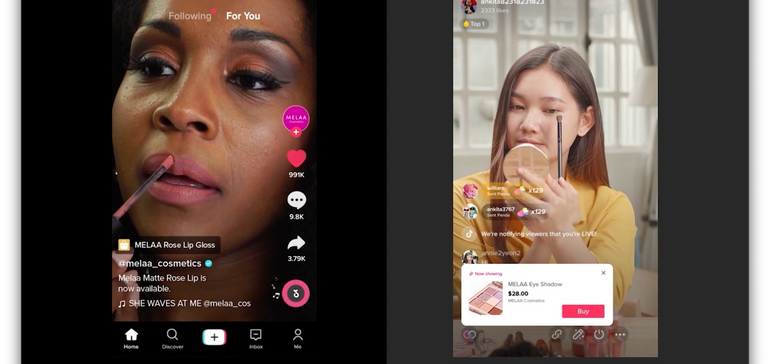SOCIAL
Live-Stream Commerce Offers Big Potential for TikTok’s Growth Prospects

Predicting the future of social media marketing trends is always difficult, with new functions continuously emerging, and the sheer amount of apps gaining attention at any one time making it impossible to stay across every single new thing.
But if you want to know the future of TikTok, you have an advantage, because TikTok’s coming trends are already happening in China, with the Chinese version of the app, called ‘Douyin’, being used by over 600 million people, and already well ahead of TikTok in terms of development.
That’s why many of TikTok’s new features seem so well-formed, and why its algorithms seem so advanced – because it’s been refining them since 2016, when Douyin was first launched for mainland Chinese users.
So what’s the key trend on Douyin right now?
Live-stream commerce is the thing, with sales generated via Douyin live broadcasts rising 7x year-over-year in 2021, and the number of eCommerce live broadcast users exceeding 384 million – more than half the platform’s user base.
The live shopping trend is huge in China, with predictions that live shopping revenues will reach $400 billion in the region this year alone, which is equivalent to almost half of all eCommerce spending in the US last year. In addition, live-stream commerce is also increasingly popular among younger audiences, with users aged 27 and under seeing the fastest adoption of live-stream shopping.
If you were trying to get a gauge on the next big focus for TikTok, and where things are headed with its plans, this is where you should be looking.
And it’s already happening – as recently reported by NBC:
“Dozens of accounts on TikTok go live nearly every day to hawk stuffed animals, colored contact lenses, keychains, shoes, phone cases, faux leather purses, makeup tools, as well as a plethora of other goods. Some influencers have amassed more than 100,000 followers and regularly have hundreds or thousands of people watching their livestreams concurrently.”
Interestingly, many of these accounts are China-based, meaning that it’s often, at least right now, Chinese broadcasters expanding their market reach, while NBC also reports that TikTok is assisting some of these streamers in building their businesses in the app, as it looks to build on its eCommerce potential.
Which is a key focus for its monetization plans. At present, TikTok offers limited revenue potential, by comparison to, say, YouTube, because it can’t offer direct content monetization in the same way, due to its lack of in-stream and pre-roll video ads. You can’t insert ads into 30-second clips, which means that TikTok is at something of a disadvantage in terms of helping creators get paid for their uploads.
That’s already led to rumblings of unrest within the creator community – but maybe, if TikTok can facilitate a whole new market in live-stream commerce, that’ll enable it to negate any potential loss of talent that could come about due to creators not getting paid as they would like. If TikTok can replicate Douyin’s success with live-stream shopping, that could see more than 500 million users becoming active consumers in the app, fueling a whole new creator economy, and securing its future through enhanced connection, engagement and monetization.
So how will TikTok do it?
We’ve already seen the first inklings of this, with tests of live-stream shopping in partnership with Walmart and other retailers in the app.

The next iteration of this will include more live-stream functionality, with several additional options already present in Douyin.
These include simplified live-stream purchasing via one-click buying buttons:

Additional landing page components for live broadcasts:

There are also physical location components and other elements to drive off-platform purchases.

Douyin also has dynamic shopping tags and product buttons that appear in-stream (as in the top screenshot) enabling easier buying as you watch.
Some of these are already in the works, but you can expect more options making their way to TikTok soon, while there are also more ways to utilize the platform’s existing live-stream functions, like co-hosting with a second-screen.

Essentially, there are many tool that TikTok can add to evolve its live-stream shopping experience. And as it continues to grow, and develop its systems, that looks set to be a big focus moving forward.
But will live-stream commerce catch on in western nations as it has in China?
Many Chinese trends have failed to take hold in the same way – take Messenger Bots for example, which Meta made a big push on back in 2016. At the time, following Chinese usage trends, Zuck and Co seemed convinced that the increasing use of Messenger signaled the way forward for consumption habits, but Messenger Bots never really caught on, and Messenger hasn’t become the all-inclusive utility that Chinese messaging apps, like WeChat and QQ, have.
That might not be a great sign for TikTok’s prospects, but then again, as noted, the initial signs are there, and there is a level of interest in live-stream commerce already, which could signal growth potential.
And even if it doesn’t become the massive trend that it has on Douyin, even a quarter of TikTok’s users becoming engaged live-stream shoppers would still be significant.
There’s a way to go in determining the potential, but if you were looking for what’s coming next on TikTok, this is definitely a key element to watch.
Source link



















You must be logged in to post a comment Login